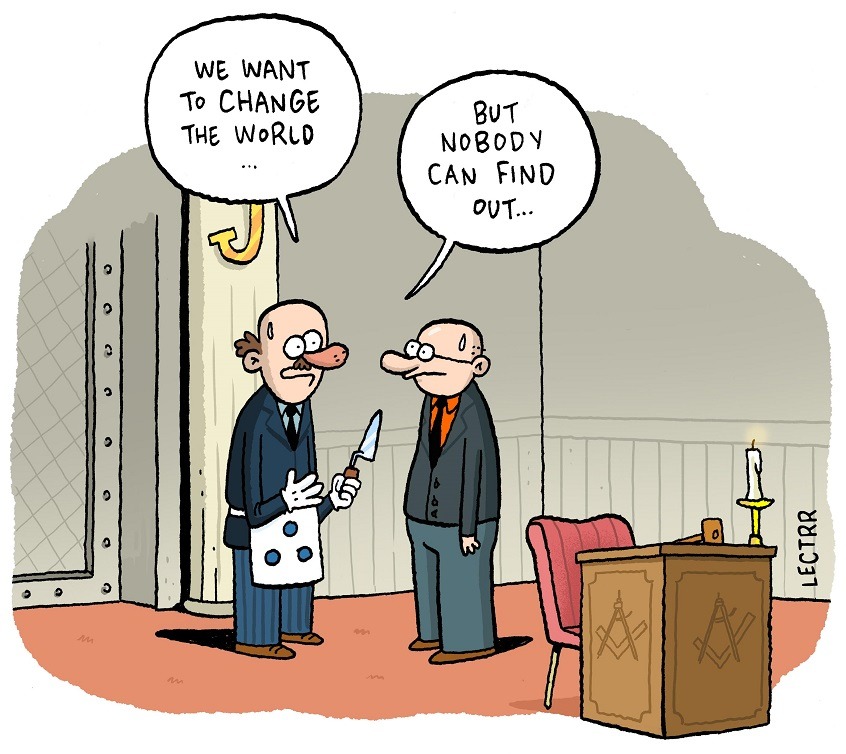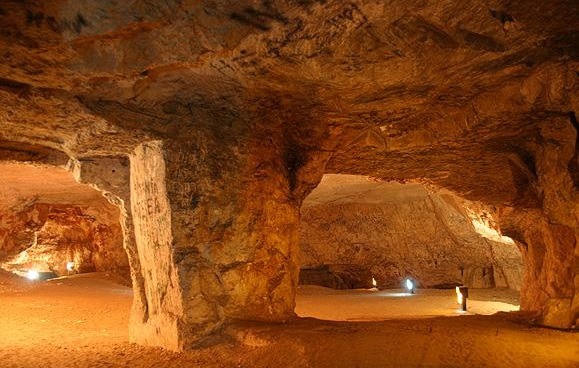Among the many museums in Brussels, the Belgian Museum of Freemasonry, located at 73 Rue de Laeken in the city centre, is arguably one of the most fascinating.
Freemasonry is an ancient order of brotherhood, surrounded by myths of secrecy, but here we have a museum that declares, at the entrance, its intention to enhance transparency and to shed some light on the ideology and history of Freemasonry in Belgium.
The museum contains an exhibition in the so-called meditation hall where new candidates applying to become members of the Freemason lodge are received. There is also a “Temple” inside the building where the ceremonies take place. Access to the Temple is allowed for guided groups but the ceremonies are not open to non-members.
Once a secretive organization persecuted by totalitarian Fascist, Nazi and Communist regimes alike, Freemasonry is today a much more open association with “Grand Lodges” in many countries. However, its origin is still shrouded in mystery.
Historical traditions
There are basically two historical traditions: the Biblical one and the mediaeval one. According to the Biblical tradition, which seems to be the dominant one and is reflected in the symbols of most national lodges, Jerusalem, where the Temple of King Solomon was located, is the cradle of Freemasonry. King Solomon is considered to be the first Grand Master of Freemasonry.
The name Jerusalem contains “salem” which in Hebrew means peace and perfection. These are two important concepts in Freemasonry and relate both to the outside world and to the inner self of the individual. A Talmudic saying talks about “builders”: “What are bana´im (Hebrew= builders), asked Rabbi Jochanan: They are scholars who are engaged all their days in the building of the world”.
An archaeological site linked to the Masonic legend can be found in Jerusalem. It is the so-called Zedkiyahu’s cave, located near the Damascus gate of the old city in Jerusalem and named after the last king of the kingdom of Judah.
Stones are supposed to have been quarried there for the first Temple of King Solomon in the mid-tenth century BCE and–after its destruction by the Babylonians in 587 BCE–the second Temple which was later rebuilt by King Herodes and destroyed by the Romans in 70 CE.
From the entrance to the cave, the main path leads for nearly 235 meters until it reaches a large cave called “The Freemasons Hall”. During the British mandate period, chunks of stone were quarried from the rock in the cave and dispatched by sea to various countries to be used as foundation stones for newly erected Masonic lodges.
According to the other tradition, Freemasonry dates from the Templars and other Christian knights’ orders in the Crusader Kingdom in Jerusalem and later in Europe through the Middle Ages. Some national lodges were influenced by these orders and limited membership to Christians. Ironically, Freemasons and Jews were both targets of anti-Semitic propaganda.
When Nazism came to power in Germany, it started a campaign to destroy both Freemasons and Jews. In Brussels, an anti-Freemason and anti-Jewish exhibition took place in 1943 close to where the Freemason museum is located today. Belgian freemasons were persecuted and murdered by the Nazi occupiers and their quislings.
Universal brotherhood
Historically, the modern version of Freemasonry originated in England with the establishment in 1717 of the Grand Lodge of England, the “mother lodge” of all lodges. From there, Freemasonry spread to Scotland and countries on the continent under the jurisdiction of already established lodges. They were probably preceded by guilds of apprentices, craftsmen and masters in building.

The lodges started to accept members who were not craftsmen, and they soon became the majority, using the old building tools as symbols. From the very start, membership was open to all interested persons, regardless of background and faith, based on a principle of universality: “A man is to be judged by his individual merit and not by the social collective to which he belongs”.
This would normally be the case in the rest of Europe. Due to the rise of anti-Semitism, Jews became barred from joining most lodges in Germany. In Sweden, membership is still restricted to Christians. In other countries, Freemasonry became a common social framework, composed by prominent members of society, and linked to the emancipation of marginalized and deprived groups in society.
“A Mason is oblig'd by his tenure, to obey the Moral Law; and if he rightly understands the Art, he will never be a stupid Atheist, or an irreligious Libertine. But though in ancient Times Masons were charg'd in every Country to be of the Religion of that Country or Nation, whatever it was, yet 'tis now though more expedient only to oblige them to that Religion in which all Men agree, leaving their particular Opinions to themselves.” Extract from the first statues of the Grand Lodge of England, 1723 |
The Brussels Times sat down with Joseph M. Asselbergh, president of the museum, to learn more about the history of Freemasonry in Belgium.
Q: Many of the Masonic activities seem to consist of secret rituals and ceremonies. Non-members are not allowed to attend them and members are forbidden to disclose them. Why?
A: Free thinking and free speech are essential in Freemasonry, as well as bringing people together with different backgrounds. Nobody speaks free if he or she knows that what is said might be disclosed or leaked. It’s rather about discretion than secrecy. Every Freemason can speak freely about himself but not about others. Information about rituals and ceremonies can be found in a lot of books and on the internet.
Q: How easy or difficult is it to become a member of a lodge in Belgium? Which are the conditions? How many members are there in all Belgian lodges and is the number increasing?
A: You can become a member when asked as well as after contacting a lodge or a Masonic body. Nowadays a lot of people find their way to Freemasonry via the internet. There are some 25 000 Freemasons in Belgium, of whom one third are women. This number is slowly increasing, contrary to the case in other countries, where Freemasonry once had a strong following, such as the US and UK.
Q: Freemasonry dates to the stonemason guilds in the Middle Ages, but the legend says that there is also a link to King Solomon and his Temple. For example, the main hall where the ceremonies take place is called Temple. Could you please explain this symbolic connection?
A: The link with the stonemason guilds is contested – for some it is a truth, for others it is a myth. The latter see Freemasonry as a movement of free thinkers with a focus on rebuilding the societies in Europe after more than a century of religious disputes and wars.
But it is clear that Freemasons use three kinds of symbols: “light” as a symbol of truth, knowledge, and wisdom. Many religions also use light as a symbol, for example Christianity in the Easter holiday and Judaism in the Chanukah holiday. Another symbol is King Solomon’s Temple in ancient Jerusalem.
The Temple emerged in the 16th century as an ideal of the perfect building. The architects of the palace of Philippe II of Spain and Saint Paul’s cathedral, as well as many others, claimed to be inspired by the Temple. Moreover, Jewish thinking was very popular during the 17th century, so the idea of Temple transcended from an ideal architecture to the ideal of a perfect society. It’s the latter idea that is alive in the symbolism of Freemasonry.
The third symbol is the idea of a building as a metaphor for improvement and progress: building tools as the square and the compass and activities as shaping a rough stone to a perfect stone fitting in a building.
Q: Freemasonry seems to have played an important role in Belgium’s history, especially during the 19th century after the establishment of the Belgium kingdom. The Free University of Brussels (ULB) was founded in 1834 by a group of Freemasons. What were Freemasonry’s major achievements and contributions to Belgian society?
A: Freemasonry was perhaps the first civil society association in Europe. Before it emerged, people met each other mostly in guilds and religious services. It’s no wonder that both churches and governments were critical of Freemasonry and wanted to outlaw it, especially in Catholic countries. After 1815, the Roman-Catholic church tried to regain the influence it had lost during the period of the French revolution and the reign of Napoleon.

Joseph M. Asselbergh, president of the The Belgian Museum of Freemasonry
Freemasonry was inspired by liberalism and advocated freedom of religion for Protestants and Jews. It also supported general education for all citizens, free from religious influence or indoctrination.
In Belgium some of these ideas were shared by King William I of the United Kingdom. After Belgium became independent in 1830, the Catholic Church claimed to be a champion of the new nation and tried to label Freemasonry as “orangist”, which in the case of some lodges was true. The Church forbade Catholics from joining the Freemason lodges. This was during a period when voting rights were limited to wealthy people.
This explains why Freemasonry in Belgium became the breeding ground of political liberalism with general education and “one man, one vote” as key issues.
Q: Freemasons were persecuted in Belgium by Nazi Germany during the Second World War. Was it mainly because they were seen as a threat to the Nazi dictatorship, or because they participated in the resistance against the Nazi occupation?
A: Dictatorships don’t like Freemasonry because of its liberalism and universal message of tolerance and brotherhood. The Nazis had more reasons to persecute the Freemasons: they saw a link with Judaism and even believed Freemasons possessed secret knowledge, which Nazi-Germany could use for its own goals. This is illustrated by their confiscation of Masonic archives and documentation. Most of this documentation was found later in Moscow and has been restituted.
Q: How would you describe the role of Freemasonry in today’s society? Is it an active civil society organisation or a secretive organisation, which mainly cares for its own members?
A: Freemasonry is an organisation that aims at the self-development of its members and promotes tolerance by bringing people together that otherwise would never have met.
Q: Compared with Freemasonry in other countries, for example Sweden, the Belgian Freemasons seem more open-minded and liberal and accept women in mixed lodges and people of all faiths (or non-faith) as members. How do you explain this? And does it prevent cooperation between national lodges?
A: Freemasonry developed differently in Protestant/Lutheran and Catholic countries. The hostility of the Catholic Church pushed the lodges in Catholic countries to a more liberal and free-thinking orientation, which included a more progressive attitude towards the participation of women in Freemasonry in either mixed or only-women lodges.
Q: The exhibition at the museum highlights freedom and the search for truth. How does the lodge promote these values among its members? Is the Freemason ideology mainly moral, political or religious?
A: There is no specific Masonic ideology. It’s is an ethical value system that by its rituals and meetings allows participants to become active listeners, learn from other members, gather information and form their own opinions, which of course differ from person to person. There are no votes or consensus decisions.
By Mose Apelblat
The Belgian Museum of Freemasonry
The museum is located in a neo-classical building (Hotel Dewez) at rue de Laeken 73 in the city centre of Brussels. It displays a variety of items such as regalia, jewels, china and books from the 18th century to the present day. These bear witness to the historic evolution, activities, ideas and current structure of Freemasonry in Belgium.
Information about events and guided tours can be found at the museum’s website: www.mbfm.be

